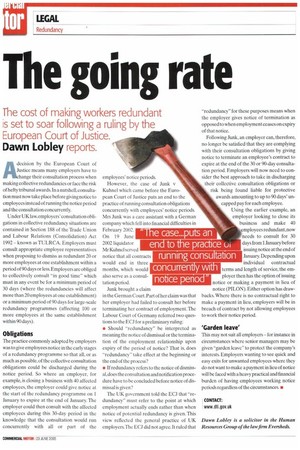The going rate
Page 44

If you've noticed an error in this article please click here to report it so we can fix it.
The cost of making workers redundant
is set to soar following a ruling by the
European Court of Justice.
Dawn Lobley reports.
Adecision by the European Court of Justice means many employers have to hange their consultation process when making collective redundancies or face the risk of hefty tribunal awards. In a nutshell, consultation must now take place before giving notice to employees instead of running the notice period and the consultation concurrently.
Under UK law,employers' consultation obligations in collective redundancy situations are contained in Section 188 of the Trade Union and Labour Relations (Consolidation) Act 1992 — known as TULRCA. Employers must consult appropriate employee representatives when proposing to dismiss as redundant 20 or more employees at one establishment within a period of 90 days or less. Employers are obliged to collectively consult "in good time" which must in any event be for a minimum period of 30 days (where the redundancies will affect more than 20 employees at one establishment) or a minimum period of 90 days for large-scale redundancy programmes (affecting 100 or more employees at the same establishment within 90 days).
Obligations
The practice commonly adopted by employers was to give employees notice in the early stages of a redundancy programme so that all, or as much as possible, of the collective consultation obligations could be discharged during the notice period. So where an employer, for example, is closing a business with 40 affected employees, the employer could give notice at the start of the redundancy programme on 1 January to expire at the end of January. The employer could then consult with the affected employees during this 30-day period in the knowledge that the consultation would run concurrently with all or part of the employees' notice periods.
However, the case of Junk v Kuhnel which came before the European Court of Justice puts an end to the practice of running consultation obligations concurrently with employees' notice periods. Mrs Junk was a care assistant with a German company which fell into financial difficulties in February 2002. On 19 June 2002 liquidator Mr Kuhnel served notice that all contracts would end in three months, which would also serve as a consultation period.
Junk brought a claim in the German Court. Part of her claim was that her employer had failed to consult her before terminating her contract of employment. The Labour Court of Germany referred two questions to the ECJ for a preliminary ruling: • Should "redundancy" be interpreted as meaning the notice of dismissal or the termination of the employment relationship upon expiry of the period of notice? That is. does "redundancy" take effect at the beginning or the end of the process?
• If redundancy refers to the notice of dismissal, does the consultation and notification procedure have to be concluded before notice of dismissal is given?
The UK government told the ECJ that "redundancy" must refer to the point at which employment actually ends rather than when notice of potential redundancy is given. This view reflected the general practice of UK employers. The ECJ did not agree. It ruled that "redundancy" for these purposes means when the employer gives notice of termination as opposed to when employment ceases on expiry of that notice.
Following Junk, an employer can, therefore, no longer be satisfied that they are complying with their consultation obligations by giving notice to terminate an employee's contract to expire at the end of the 30 or 90-day consultation period. Employers will now need to consider the best approach to take in discharging their collective consultation obligations or risk being found liable for protective . awards amounting to up to 90 days' uncapped pay for each employee.
Using the earlier example, an employer looking to close its business and make 40 mployees redundant,now needs to consult for 30 days from 1 January before issuing notice at the end of January Depending upon individual contractual terms and length of service, the employer then has the option of issuing notice or making a payment in lieu of notice (FELON). Either option has draw backs. Where there is no contractual right to make a payment in lieu, employers will be in breach of contract by not allowing employees to work their notice period.
'Garden leave'
This may not suit all employers for instance in circumstances where senior managers may be given "garden leave" to protect the company's interests. Employers wanting to see quick and easy exits for unwanted employees where they do not want to make a payment in lieu of notice will be faced with a heavy practical and financial burden of having employees working notice periods regardless of the circumstances.
CONTACT: www. gOV.uk












































































































































































































